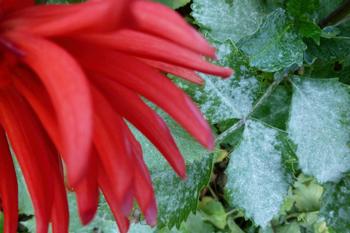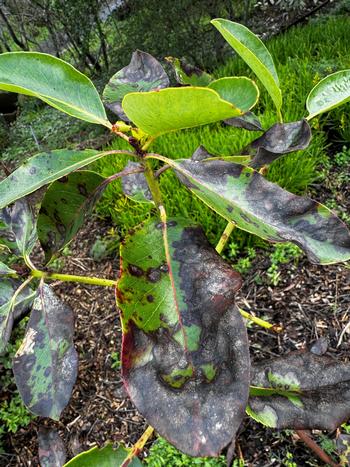Fungal diseases of plants
-
Martha Proctor
-
Fungi are the most common causal agent of plant disease. Of the more than two to four million species of fungi worldwide, eight thousand are known to be detrimental to plants. These microscopic organisms cause symptoms such as root and crown wilts, leaf spots, rusts, cankers, downy and powdery mildews, and stem and twig blights. Blights cause severe damage to a plant structure, e.g., leaves, flowers, or stems; rots are typically caused by soil-borne fungi attacking roots, stems, and fruits; Cankers appear as sunken areas or spots where the bark is rough, missing, or swollen, and wilts are the result of fungi growing inside a plant's vascular or fluid-conducting tissue causing these tissues to die.
 Powdery mildew on a dahlia. Photo: Martha Proctor
Powdery mildew on a dahlia. Photo: Martha ProctorBecause the presence of fungi is not always visible on a plant's surface, they are often identified by their growth patterns, spores, or other structures. Fungi absorb nutrients through tiny thread-like filaments called hyphae. A collection of hyphae on a plant is a key diagnostic sign that can lead to identifying a specific fungus. Examine infected plant tissue with a hand lens, or if further assistance is needed, bring a sample to the Marin Master Help Desk in Novato. The sample can be viewed under a microscope or put onto a petri dish with a nutrient medium to see if identifiable fungi grow out.
Monitor your plants. If a plant appears stressed and symptoms appear, examine the plant for symptoms and signs of injury or disease. Determine the most likely cause by first accurately identifying the host plant: every species, variety, or cultivar has a unique set of characteristics that often provide important clues to identifying the source of the problem. Fungi are often very host-specific.
The use of genetically resistant plants, if available, should be the first line of defense for diseases caused by fungi. Good cultural practices in genetically resistant plants can often slow or limit the incidence of fungal disease. Fungicide applications can supplement preventative control measures if/when a fungal disease persists despite the above efforts. Foliar blight on Pacific madrone in Inverness. Photo: Martha Proctor
Foliar blight on Pacific madrone in Inverness. Photo: Martha ProctorFungicides are typically more effective when applied preventively but can also be effective when applied after the onset of symptoms. In either case, fungicides must be delivered to the area of the plant where the pathogen is active to be effective. Accurate diagnosis of the fungi is critical to selecting the appropriate fungicide since they vary in their efficacy. Always follow instructions on the fungicide label regarding timing of use and weather conditions.
Controlling plant diseases with cultural practices involves preventing a conducive environment for fungal growth and improving the growing conditions for maximum plant health. Purchase healthy, vigorous plants and carefully inspect the root system before planting. Study the plant's normal growth habits and requirements (soil type, pH, exposure, drainage, exposure) and learn the common problems to which that plant type is vulnerable. Learn from reliable sources how common diseases for that cultivar type are treated.
Fungal leaf spots and blights (e.g., anthracnose) can be better managed by growing resistant cultivars. Plants with leaf spots, the most prevalent of all plant diseases, or downy mildew fare better by limiting overhead irrigation. Too little water stresses plants, making them more susceptible to disease organisms, e.g., canker fungi; excessive watering results in greater susceptibility to root diseases. Careful watering, sterile pots, and uncontaminated, soil-less seedling mixes help reduce the incidence of rots.
Rotate vulnerable plants to a different spot each year to disrupt year-to-year pest cycles. Prune twigs and branches from woody plants infected with blight or fungal canker diseases. Turn the soil after harvest to help break down small roots that may harbor fungi. Removing plant debris and infected plant parts minimizes disease spread and reduces overwintering spores—Disinfect tools/machinery with household bleach in a 10% solution of bleach and water.
Prevention is the best approach for most plant diseases.


